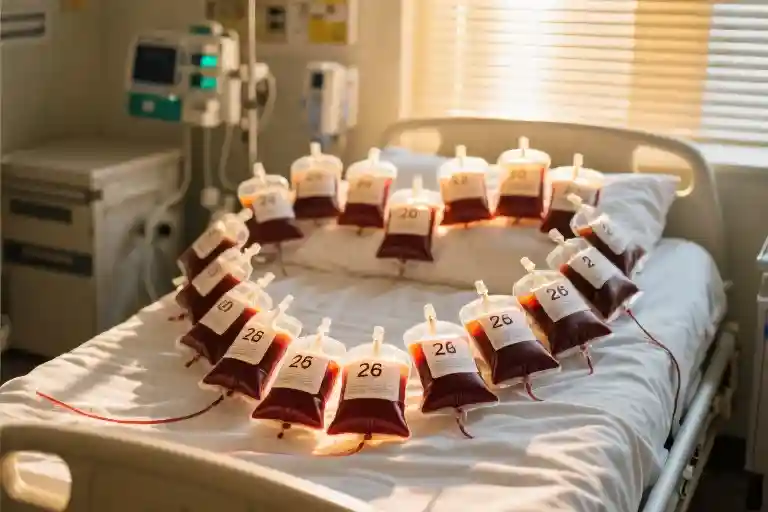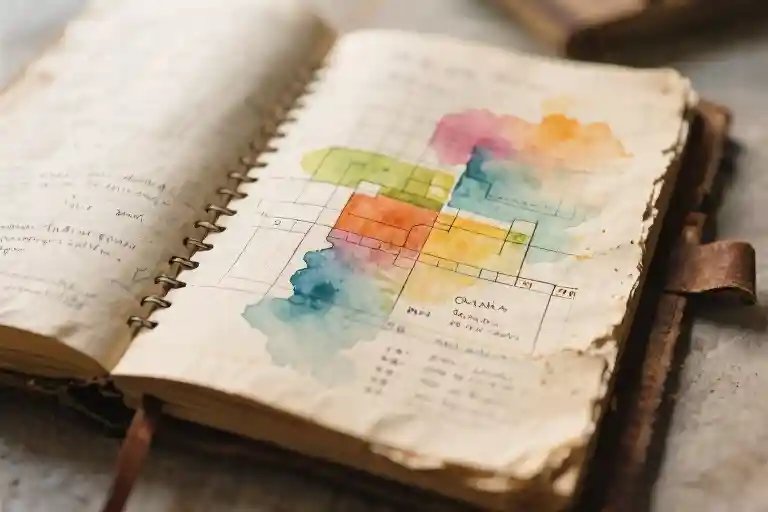The fluorescent lights flickered above the gurney as it rattled toward the operating room for the second time that night. My fingers clutched at the starched hospital sheet, the fabric damp with sweat and something darker. ‘I don’t want to die,’ I whispered to the nurse adjusting my IV line. Her practiced hands paused for half a heartbeat before she answered, ‘You’re not going to.’ But the way her pupils dilated—just for an instant—told a different story.
Beeps from the heart monitor marked time in erratic bursts, each shrill note syncing with the throbbing behind my eyes. The scent of antiseptic couldn’t mask the metallic tang of blood—mine—soaking through layers of surgical draping. Some detached part of my brain noted how the anesthesiologist’s shoulders tensed when the OB barked orders about platelet transfusions. Between waves of nausea, I caught fragments: ‘placenta accreta…26 units…crash section…’
As the oxygen mask descended, my final coherent thought wasn’t about unfinished bucket lists or profound last words. Just the crushing weight of all the hours spent people-pleasing—grading papers until midnight to prove dedication, attending pointless meetings to appear cooperative, swallowing opinions to maintain harmony. The bitter arithmetic of a life measured in others’ expectations rather than my own truth.
Then darkness.
When consciousness returned hours later, it arrived with twin realizations: the warm bundle against my chest was breathing, and so was I. Against statistical probabilities, we’d both survived the postpartum hemorrhage that claims nearly 100,000 mothers globally each year. The neonatal intensive care unit hummed around us, its symphony of alarms and murmured consultations underscoring our improbable presence. My fingers traced the outline of my son’s miniature ear—downy and perfect—while the memory of those panicked moments before anesthesia kept replaying like a corrupted file.
That nurse’s microexpression haunted me. Not the reassuring words, but the split-second fear in her eyes that said what the hospital protocol couldn’t: This might actually be the end. It was the look you give someone boarding a plane you know will crash. And in that suspended moment between her statement and my surrender to unconsciousness, an unexpected clarity emerged—if I survived, the performative martyrdom ended here. No more conflating self-erasure with virtue. No more mistaking exhaustion for dedication.
The revelation felt less like an epiphany and more like finally acknowledging what my body had known for years. The chronic migraines started during my third year of teaching, coinciding with taking on extracurriculars no one else wanted. The back spasms began when I stopped using planning periods for bathroom breaks. Even my uterus seemed to protest—this catastrophic hemorrhage occurring after years of ignoring abnormal bleeding cycles to avoid ‘making a fuss.’
Now, watching the sunrise paint the NICU walls peach and gold, I inventoried the costs of my compliance. Not in abstract terms, but in measurable losses: 1,842 hours spent on non-teaching duties to appear ‘helpful,’ $14,600 in unpaid overtime across seven years, three miscarriages I never discussed because ‘others have it worse.’ The math was unforgiving—I’d been slowly hemorrhaging autonomy long before the medical emergency.
Somewhere beyond the drawn curtains, a newborn wailed—another mother’s miracle, another family’s reset button. My fingers found the call button, not for pain medication but to request a pen and paper. If death had brushed this close and left me standing, the least I could do was stop pretending the things that drained me were noble sacrifices rather than unexamined choices. The first words I scrawled on the hospital notepad weren’t a will or final message, but a question so basic it shamed me: ‘What do you actually want?’
Not what the school district wanted from its teacher of the year. Not what my parents expected from their dutiful daughter. Not what mommy blogs prescribed as ideal motherhood. Just me, in this broken and blessed body, with whatever time remained.
The answer, when it came, arrived not in words but sensations—the craving for quiet mornings without alarm clocks, the visceral pull toward creative work that made hours dissolve, the longing to parent from abundance rather than exhaustion. Simple hungers I’d intellectualized away as impractical or selfish. Yet here in this antiseptic limbo between near-death and second chances, they felt like the only truths worth honoring.
The Price of 26 Blood Bags
The metallic taste of oxygen mask plastic still lingers in my memory when I recall those 120 minutes that redefined my understanding of time. Placenta accreta spectrum – three clinical words that nearly cost me everything. What began as routine labor spiraled into an obstetric emergency where minutes weren’t measured in contractions but in blood loss percentages.
Medical staff moved with choreographed precision, their calm voices belying the urgency in their eyes. I learned later that the OR team activated their massive transfusion protocol before I even reached the operating table, those 26 units of packed red blood cells waiting like liquid lifelines. The anesthesiologist’s steady countdown (’15 seconds to intubation’) became my anchor point between consciousness and the void.
What they don’t tell you about postpartum hemorrhage is the peculiar detachment that sets in. As my blood pressure plummeted to 60/40, a strange clarity emerged – watching the chaos from some elevated vantage point while simultaneously feeling the crushing weight on my chest. The cardiac monitor’s erratic beeping seemed to sync with the nursery’s wall clock, each passing second marked by another bag of blood disappearing into my veins.
In the ICU, I’d overhear nurses discussing my case in hushed tones. ‘Gave us quite the scare with that systolic drop,’ one would say while adjusting my IV lines. Only then did I grasp the cruel irony – my newborn’s perfect Apgar score of 9/9 existed alongside my near-fatal blood loss. Modern obstetrics can measure infant vitality down to precise numerical values, yet maternal survival still hangs on swift clinical judgment and sheer luck.
The resuscitation team’s unspoken triage system revealed itself in subtle ways. The way the lead surgeon positioned herself between me and the fetal monitor during critical moments. The charge nurse’s strategic placement of extra compression bandages before they were needed. These professionals knew what I was only beginning to understand – that surviving traumatic birth isn’t about dramatic heroics, but about anticipating cascading failures before they occur.
When the hematology report finally showed my hemoglobin stabilizing at 7.8 g/dL, the relief in the room was palpable. But numbers tell incomplete stories. No lab value could quantify what it meant to wake from that second surgery clutching the hospital gown where my newborn should have been nursing. Or how the scent of isopropyl alcohol would later trigger phantom pains where my uterus fought to remain intact.
Twenty-six units of donated blood bought me back from the edge, each bag representing someone’s ordinary act of kindness that became extraordinary in my context. The transfusion tags still dangled from my IV pole like bizarre price tags – crimson receipts for a second chance I hadn’t known to request. As dawn filtered through the recovery room blinds, I traced the tubing from those cold plastic bags to the warmth of my own pulse point, marveling at how life could simultaneously feel so fragile and so insistent.
The People-Pleaser’s Blood Loss Report
The fluorescent lights of the hospital room hummed like a persistent mosquito, casting sterile shadows across the clipboard where I tallied my emotional losses. Twenty-six bags of blood had replenished my veins, but nobody was transfusing the parts of me I’d hemorrhaged over years of saying “yes.”
The Energy Vampires in the Teacher’s Lounge
Mrs. Henderson always needed someone to cover her lunch duty. The principal “just knew” I’d volunteer for the after-school program. My classroom became Grand Central Station for every colleague’s crisis – the broken copier, the misplaced lesson plans, the parent who needed “someone more diplomatic” to handle their complaint. Each interaction left invisible puncture wounds, my boundaries as permeable as the IV line dripping saline into my arm.
Research confirms what my body already knew: chronic stress alters white blood cell counts. No wonder I caught every classroom cold while grading papers at 2 AM. The math never added up – 63 hours weekly invested in other people’s priorities, 17 minutes reserved for my own. A curriculum coordinator once praised my “team player” attitude while denying my maternity leave extension request. The IV pump’s rhythmic beeping now sounds like a metronome keeping time for all the compromises I conducted in perfect tempo.
The Overcompensation Ledger of Motherhood
Before the hemorrhage, I’d created color-coded spreadsheets tracking pediatrician visits, homemade organic purees, and developmental milestones. Social media showcased my perfectly curated playdates, but nobody saw the panic attacks in the supermarket when the baby cried. “Maternal instinct” became code for swallowing every need until I choked on the silence.
Postpartum surveys never ask the right questions:
- On a scale of 1-10, how often do you pretend to enjoy unsolicited parenting advice?
- How many hours have you spent researching sleep training instead of sleeping?
- When was the last time you peed without an audience?
The fetal monitor’s printout had more defined boundaries than my personal life. Every spike in its jagged lines now mirrors the adrenaline surges I ignored when playing the role of “effortlessly perfect mom.”
The Clinical Correlation Between Pain and Politeness
My physical therapist traced my chronic back pain to “teacher posture” – that contortion we do when leaning over student desks while keeping our skirts wrinkle-free. The rheumatologist called it fibromyalgia. The truth? It’s the somatic price of folding ourselves into socially acceptable shapes.
Studies on “disease-prone personalities” identify my exact profile: high agreeableness, low assertiveness, and suppressed anger that metastasizes as inflammation. The hospital’s pain scale (0-10) never captured the dull ache of smiling through staff meetings when my ideas got steamrolled. Nobody prescribed medication for the headache that came from nodding along to outdated pedagogy.
As the morphine drip softened my postoperative pain, I realized: we lack medical terminology for the slow bleed of self-betrayal. The EKG showed sinus rhythm, but where’s the monitor for a soul operating at half-capacity?
This hospital gown makes visible what I’ve always known – we are fragile beings pretending to be bulletproof. The stains on these sheets tell the truth my lesson plans never could: you can hemorrhage dignity just as catastrophically as blood. When the phlebotomist drew vial after vial for tests, I wondered – what would they find if they screened for dissolved dreams in my plasma?
The newborn in the bassinet beside me knows nothing of performative niceness. His cries are pure, unedited need. Watching his tiny chest rise, I begin drafting a new curriculum – one where setting boundaries counts as continuing education, and self-preservation gets graded as extra credit.
The Ledger of a Second Life
The hospital room’s fluorescent lights hummed overhead as I traced the edges of my newborn’s tiny fingernails. Between the rhythmic beeping of the IV pump and the distant chatter of nurses, an unexpected clarity settled over me – the kind that only comes when death brushes close enough to fog your glasses. My near-death experience during childbirth had left me with more than surgical scars; it handed me an urgent accounting of my remaining days.
Three Ways to Count What’s Left
- The Pediatrician’s Method
Simple division: if I lived to my mother’s age of 78, I had 14,245 days remaining. The number seemed generous until I subtracted 8 hours daily for sleep (4,748 days gone), 3 hours for chores (1,781 days evaporated), and 10 hours for work (5,935 days allocated). The remainder – 1,781 truly discretionary days – could fit inside a single presidential term. - The Moon Phase Calculation
My postpartum therapist suggested measuring in lunar cycles. “Women’s bodies understand moons better than calendars,” she said, placing a moon phase chart over my recovery timeline. At 35 years old, I’d already lived through 420 full moons. Statistically, I might see 500 more. The revelation? I’d already burned through 45% of my moonlight. - The Kindergarten Metric
Watching my toddler stack blocks, I realized parenthood measures time in school years. From birth to college graduation spans exactly 18 back-to-school nights. That September, I’d already missed my eldest’s first “real” school photo day because of a department meeting. Eighteen chances to witness childhood milestones – and I’d traded one for photocopies and lesson plans.
Five Exit Ramps from the Classroom
The heart monitor’s steady pulse became a metronome for my career reckoning. Teaching had been my identity for twelve years, but the postpartum hemorrhage PTSD reshuffled my priorities. Here’s the cold-eyed assessment I scribbled on a hospital napkin:
- Educational Content Creator
Leveraging lesson planning skills to build online courses. Pro: Existing teacher network. Con: Still tied to standardized testing frameworks. - Parenting Coach
Channeling years of managing 30-child classrooms into guiding overwhelmed mothers. Pro: Natural skill transfer. Con: Requires certification investments. - Hospital Parenting Educator
Creating trauma-informed resources for NICU families. Pro: Meaningful use of my lived experience. Con: Limited earning potential. - Children’s Book Author
Translating bedtime stories invented for my students into published works. Pro: Creative fulfillment. Con: Highly competitive market. - Teacher Transition Consultant
Helping other educators navigate career changes. Pro: Addressing a growing need. Con: Requires business development skills.
Each option glowed briefly like the call buttons above my hospital bed before revealing their shadows. The IV in my arm became a physical manifestation of choice paralysis – too many potential paths dripping slowly into my veins.
White Space in the Mom Blog Universe
Between midnight feedings, I conducted market research on my phone. The mommy blogosphere overflowed with curated perfection, but three underserved niches emerged:
- Post-Traumatic Growth Parenting
No one was speaking honestly about raising children while recovering from birth trauma. The existing content either medicalized the experience or glossed over it with toxic positivity. - Teacher-Mom Hybrid Wisdom
Classroom management strategies adapted for home use remained an untapped resource. Most parenting advice came from either childless experts or mothers without educational training. - Midlife Reinvention Narratives
The internet loved young mommy bloggers and empty-nester grandmas, but offered little for those rebuilding identities in the messy middle.
The cardiac monitor’s erratic spikes mirrored my rising excitement. Here was my intersection – the place where my professional training, personal trauma, and hard-won insights could meet a genuine need. Not another parenting blog, but a field guide for women emerging from their own life-quakes, still trailing IV lines of doubt but learning to walk toward what matters.
As dawn crept through the hospital blinds, I tapped out my first post on my phone: “26 Units of Clarity: What Near-Death Motherhood Teaches About Living.” The publish button hovered like a held breath – the first entry in a new kind of ledger, where time spent would be measured in truth shared rather than approval earned.
The 30-Day Rebirth Blueprint
Lying in that hospital bed with IV lines snaking across my bruised arms, I realized recovery wasn’t just about physical healing. The 26 blood bags dangling above me became a macabre metaphor – I’d been hemorrhaging self-worth long before the placental abruption. This four-week plan emerged from counting ceiling tiles during midnight feedings, each square representing an area of my life needing transfusion.
Week One: Reclaiming Physical Sovereignty
The cardiac monitor’s relentless beeping taught me more about boundaries than any self-help book. My first act of rebellion? Turning off the ‘good patient’ autopilot. Nurses would find my medication schedule clipped to the bedside table with precise notes about adverse reactions – no more nodding through dizziness to avoid being ‘difficult.’ At home, I used my postpartum recovery as legitimate armor:
- Sleep became sacred (blackout curtains, phone ban after 8PM)
- Meals transformed from afterthoughts to intentional acts (prepped during baby’s morning nap)
- Pain management stopped being a guilt trip (setting phone reminders for ibuprofen before discomfort peaked)
These weren’t luxuries; they were the scaffolding for rebuilding a body that nearly failed me. The shocking revelation? Nobody resented these changes as much as I’d imagined. My husband actually looked relieved when I handed him a printed list of freezer meals instead of pretending I could cook while healing.
Week Two: The Digital Detox
My smartphone glowed accusingly in the dark nursery, its notifications like tiny daggers: unread parent-teacher emails, faculty group chats buzzing about coverage requests. During transfusion #18, I’d realized how often I used digital busywork to avoid existential questions. The purge went beyond app deletions:
- Social Media: Unfollowed all ‘inspirational teacher’ accounts that fueled my inadequacy
- Email: Created an auto-responder detailing my medical leave (previously I’d sneak replies)
- Messaging: Muted all school-related threads (discovered 93% didn’t require my input)
The withdrawal pangs hit hard around Day 3. I’d instinctively reach for my phone during nursing sessions, only to find just the baby’s serene face staring back. That emptiness became fertile ground – by week’s end, I’d drafted three blog posts about my near-death experience in the Notes app, no longer censoring myself for imagined audiences.
Week Three: Minimum Viable Self
Pumping breast milk at 3AM, I had an epiphany about output versus essence. Just as my body knew exactly what nutrients my son needed, my psyche understood my core offerings better than any performance review. The ‘teacher’ identity had become a ill-fitting costume. Using hospital discharge paperwork as scrap, I mapped my:
- Non-negotiables: Facilitating growth, creating systems, distilling complexity
- Transferable assets: Curriculum design skills → content creation, classroom management → community building
- Energy leaks: Grading papers drained me, but one-on-one mentoring energized
The prototype emerged organically – a simple Google Doc titled ‘Postpartum Epiphanies’ shared with five trusted friends. Their reactions surprised me: ‘You should teach this’ became ‘We need this raw honesty.’ My first product wasn’t polished, but it was palpably alive.
Week Four: First Exchange of Value
On the morning of my final postpartum checkup, a former colleague Venmoed me $50 for a ‘trauma-informed teaching guide.’ I stared at the notification, remembering how I’d once graded 120 essays unpaid over spring break to prove my dedication. This transaction felt different – not exploitation, but mutual respect. That afternoon, I:
- Designed a PayPal invoice template
- Outlined three premium content ideas based on nursing journal entries
- Scheduled (yes, scheduled) a celebratory nap
The math became clear: one hour of creating authentic content energized me more than eight hours of performative teaching. My newborn’s weight gain chart mirrored my creative growth – both requiring consistent nourishment, not heroic bursts. By month’s end, I’d earned enough to cover my son’s diaper subscription, a poetic full-circle moment.
What nobody tells you about near-death clarity is how ordinary the rebirth process looks. There were no lightning bolts, just a sleep-deprived woman making slightly braver choices each day. The real transformation wasn’t in becoming someone new, but finally meeting the self I’d been too busy pleasing others to acknowledge.
(Note: For those tracking the medical journey – yes, my hemoglobin levels eventually stabilized. But the truer healing came from learning to say ‘This doesn’t work for me’ without appended apologies.)
The Light on the Discharge Papers
The sunlight made geometric patterns on my hospital discharge forms as I signed them with hands that still trembled slightly. Three weeks earlier, I’d been wheeled through these same doors fighting for my life; now I walked out holding new life in my arms. The contrast wasn’t lost on me – how ordinary moments become extraordinary when viewed through the lens of near-death experience.
My son’s tiny fingers wrapped around my index finger with surprising strength, his grip simultaneously fragile and tenacious. Neonatologists call this the palmar grasp reflex, an evolutionary remnant from our primate ancestors. But in that moment, it felt like pure metaphysics – his unconscious hold anchoring me to this world when part of me still floated somewhere between the OR and the afterlife.
You never realize how much institutional lighting resembles interrogation lamps until you’ve spent weeks beneath them. The natural sunlight outside the hospital windows seemed almost indecent in its brightness, like the universe was showing off its vibrancy just to mock my recent brush with oblivion. I squinted against it like a prisoner emerging from solitary confinement.
In the parking lot, I paused to run my fingers over the creased discharge papers. The medical jargon – ‘postpartum hemorrhage’, ’emergency hysterectomy’, ‘massive transfusion protocol’ – looked so clinical compared to the visceral memory of blood soaking through hospital pads faster than nurses could replace them. The documents listed my medications, follow-up appointments, activity restrictions. Nowhere did they mention how to reconcile your mortality with your grocery list.
My husband loaded the diaper bag into the car while I settled our newborn into his car seat. The ordinary ritual felt surreal performed by a woman who nearly became a statistic – one of those ‘maternal mortality rates’ you skim past in health articles. I caught my reflection in the car window and didn’t recognize the face looking back. Not because of physical changes (though those were evident), but because the eyes had acquired a new depth, like someone had polished away a lifetime of emotional cataracts.
As we drove away, I pressed my palm against the glass, watching the hospital shrink in the distance. Some version of me would always remain in that building – the woman who went in pregnant and came out posthumous in ways that had nothing to do with obstetrical outcomes. The rearview mirror framed the scene with cruel poetry: my sleeping son in his mirror image, the receding medical center, the road ahead still blurred with afternoon glare.
At the first stoplight, I pulled out my phone and deleted seven draft apology texts I’d composed to colleagues about my extended absence. The old me would have groveled for requiring maternity leave after nearly dying. The new me – the one who counted each of those 26 blood bags as personal resurrection tokens – simply turned off notifications from the teacher’s lounge chat.
So I’ll ask you what I asked myself that afternoon, watching sunlight dance across my baby’s eyelids: If standing at the threshold changes everything, what’s your first step across? Not the grand gesture or bucket list item, but the small, subversive act of self-ownership you’ve been postponing until some imaginary ‘right time’? Mine was letting an unread work email sit for three whole hours while I napped. Revolutionary acts come in curious packages.
Your turn.





